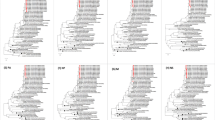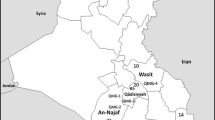Abstract
In the last few decades, frequent incidences of avian influenza (AI) H9N2 outbreaks have caused high mortality in poultry farms resulting in colossal economic losses in several countries. In Egypt, the co-infection of H9N2 with the infectious bronchitis virus (IBV) has been observed extensively during these outbreaks. However, the pathogenicity of H9N2 in these outbreaks remained controversial. The current study reports isolation and characterization of the H9N2 virus recovered from a concurrent IBV infected broiler chicken flock in Egypt during 2011. The genomic RNA was subjected to RT-PCR amplification followed by sequencing and analysis. The deduced amino acid sequences of the eight segments of the current study H9N2 isolate were compared with those of Egyptian H9N2 viruses isolated from healthy and diseased chicken flocks from 2011 to 2013. In the phylogenetic analysis, the current study isolate was found to be closely related to the other Egyptian H9N2 viruses. Notably, no particular molecular characteristic difference was noticed among all the Egyptian H9N2 isolates from apparently healthy, diseased or co-infected with IBV chicken flocks. Nevertheless, in-silico analysis, we noted modulation of stability and motifs structure of Hemagglutinin (HA) antigen among the co-infecting H9N2 AI and the IBV and isolates from the diseased flocks. The findings suggest that the putative factor for enhancement of the H9N2 pathogenicity could be co-infection with other respiratory pathogens such as IBV that might change the HA stability and function.


Similar content being viewed by others
References
AboElkhair M, Bazid AI, Abd El-Razak AG, Zidan SA, Sultan H. The role of avian influenza virus (subtypes H9 and H5) and avian infectious bronchitis virus in an outbreak associated with high mortality in poultry flocks in Egypt during 2012. Benha Vet Med J. 2014;27:21–8.
Arafa A-S, Hagag N, Erfan A, Mady W, El-Husseiny M, Adel A, Nasef S. Complete genome characterization of avian influenza virus subtype H9N2 from a commercial quail flock in Egypt. Virus Genes. 2012;45:283–94.
Arafat N, Eladl AH, Marghani BH, Saif MA, El-Shafei RA. Enhanced infection of avian influenza virus H9N2 with infectious laryngeotracheitis vaccination in chickens. Vet Microbiol. 2018;219:8–16. https://doi.org/10.1016/j.vetmic.2018.04.009.
Attwood TK, Bongcam-Rudloff E, Brazas ME, Corpas M, Gaudet P, Lewitter F, Mulder N, Palagi PM, Schneider MV, van Gelder CW. Correction: GOBLET: the global organisation for bioinformatics learning. Educ Train PLoS Comput Biol. 2015;11:e1004281. https://doi.org/10.1371/journal.pcbi.1004281.
Baigent SJ, McCauley JW. Influenza type A in humans, mammals and birds: determinants of virus virulence, host-range and interspecies transmission. BioEssays. 2003;25:657–71. https://doi.org/10.1002/bies.10303.
Bano S, Naeem K, Malik SA. Evaluation of pathogenic potential of avian influenza virus serotype H9N2 in chickens. Avian Dis. 2003;47:817–22. https://doi.org/10.1637/0005-2086-47.s3.817.
Baron J, Tarnow C, Mayoli-Nüssle D, Schilling E, Meyer D, Hammami M, Schwalm F, Steinmetzer T, Guan Y, Garten W. Matriptase, HAT, and TMPRSS2 activate the hemagglutinin of H9N2 influenza A viruses. J Virol. 2013;87:1811–20.
Benkert P, Tosatto SC, Schomburg D. QMEAN: A comprehensive scoring function for model quality assessment. Proteins. 2008;71:261–77. https://doi.org/10.1002/prot.21715.
Benkert P, Kunzli M, Schwede T. QMEAN server for protein model quality estimation. Nucl Acids Res. 2009;37:W510–4. https://doi.org/10.1093/nar/gkp322.
Benkert P, Biasini M, Schwede T. Toward the estimation of the absolute quality of individual protein structure models. Bioinformatics. 2011;27:343–50. https://doi.org/10.1093/bioinformatics/btq662.
Berjanskii M, Liang Y, Zhou J, Tang P, Stothard P, Zhou Y, Cruz J, MacDonell C, Lin G, Lu P, Wishart DS. PROSESS: a protein structure evaluation suite and server. Nucl Acids Res. 2010;38:W633–40. https://doi.org/10.1093/nar/gkq375.
Biasini M, Bienert S, Waterhouse A, Arnold K, Studer G, Schmidt T, Kiefer F, Gallo Cassarino T, Bertoni M, Bordoli L, Schwede T. SWISS-MODEL: modelling protein tertiary and quaternary structure using evolutionary information. Nucl Acids Res. 2014;42:W252–8. https://doi.org/10.1093/nar/gku340.
Bordoli L, Kiefer F, Arnold K, Benkert P, Battey J, Schwede T. Protein structure homology modeling using SWISS-MODEL workspace. Nat Protoc. 2009;4:1–13. https://doi.org/10.1038/nprot.2008.197.
Capua I, Alexander DJ. Avian influenza infection in birds: a challenge and opportunity for the poultry veterinarian. Poult Sci. 2009;88:842–6. https://doi.org/10.3382/ps.2008-00289.
Cheng J, Baldi P. Improved residue contact prediction using support vector machines and a large feature set. BMC Bioinform. 2007;8:113. https://doi.org/10.1186/1471-2105-8-113.
Fusaro A, Monne I, Salviato A, Valastro V, Schivo A, Amarin NM, Gonzalez C, Ismail MM, Al-Ankari AR, Al-Blowi MH, Khan OA, Maken Ali AS, Hedayati A, Garcia Garcia J, Ziay GM, Shoushtari A, Al Qahtani KN, Capua I, Holmes EC, Cattoli G. Phylogeography and evolutionary history of reassortant H9N2 viruses with potential human health implications. J Virol. 2011;85:8413–21. https://doi.org/10.1128/JVI.00219-11.
Galloway SE, Reed ML, Russell CJ and Steinhauer DA (2013) Influenza HA subtypes demonstrate divergent phenotypes for cleavage activation and pH of fusion: implications for host range and adaptation. PLoS pathogens 9.
Ginalski K, Grishin NV, Godzik A, Rychlewski L. Practical lessons from protein structure prediction. Nucl Acids Res. 2005;33:1874–91. https://doi.org/10.1093/nar/gki327.
Guan Y, Shortridge KF, Krauss S, Webster RG. Molecular characterization of H9N2 influenza viruses: were they the donors of the “internal” genes of H5N1 viruses in Hong Kong? Proc Natl Acad Sci U S A. 1999;96:9363–7.
Guo YJ, Krauss S, Senne DA, Mo IP, Lo KS, Xiong XP, Norwood M, Shortridge KF, Webster RG, Guan Y. Characterization of the pathogenicity of members of the newly established H9N2 influenza virus lineages in Asia. Virology. 2000;267:279–88. https://doi.org/10.1006/viro.1999.0115.
Haghighat-Jahromi M, Asasi K, Nili H, Dadras H, Shooshtari AH. Coinfection of avian influenza virus (H9N2 subtype) with infectious bronchitis live vaccine. Arch Virol. 2008;153:651–5. https://doi.org/10.1007/s00705-008-0033-x.
Hall TA. BIOEDIT: a user-friendly biological sequence alignment editor and analysis program for windows 95/98/NT. Nucl Acids Symp Ser. 1999;41:95–8.
Hassan KE, Shany SA, Ali A, Dahshan AH, El-Sawah AA, El-Kady MF. Prevalence of avian respiratory viruses in broiler flocks in Egypt. Poult Sci. 2016;95:1271–80. https://doi.org/10.3382/ps/pew068.
Hassan KE, Ali A, Shany SAS, El-Kady MF. Experimental co-infection of infectious bronchitis and low pathogenic avian influenza H9N2 viruses in commercial broiler chickens. Res Vet Sci. 2017;115:356–62. https://doi.org/10.1016/j.rvsc.2017.06.024.
Henikoff S, Henikoff JG, Pietrokovski S. Blocks+: a non-redundant database of protein alignment blocks derived from multiple compilations. Bioinformatics. 1999;15:471–9. https://doi.org/10.1093/bioinformatics/15.6.471.
Henikoff JG, Greene EA, Pietrokovski S, Henikoff S. Increased coverage of protein families with the blocks database servers. Nucl Acids Res. 2000;28:228–30. https://doi.org/10.1093/nar/28.1.228.
Hoffmann E, Stech J, Guan Y, Webster RG, Perez DR. Universal primer set for the full-length amplification of all influenza A viruses. Arch Virol. 2001;146:2275–89.
Hooft RW, Vriend G, Sander C, Abola EE. Errors in protein structures. Nature. 1996;381:272. https://doi.org/10.1038/381272a0.
Jagger BW, Wise HM, Kash JC, Walters KA, Wills NM, Xiao YL, Dunfee RL, Schwartzman LM, Ozinsky A, Bell GL, Dalton RM, Lo A, Efstathiou S, Atkins JF, Firth AE, Taubenberger JK, Digard P. An overlapping protein-coding region in influenza A virus segment 3 modulates the host response. Science. 2012;337:199–204. https://doi.org/10.1126/science.1222213.
Kahn D, Rezvoy C and Vivien F (2008) Parallel large scale inference of protein domain families. . the 14th International Conference on Parallel and Distributed Systems, Melbourne, Australia, IEEE, . pp. 72–79
Kandeil A, El-Shesheny R, Maatouq AM, Moatasim Y, Shehata MM, Bagato O, Rubrum A, Shanmuganatham K, Webby RJ, Ali MA, Kayali G. Genetic and antigenic evolution of H9N2 avian influenza viruses circulating in Egypt between 2011 and 2013. Arch Virol. 2014;159:2861–76. https://doi.org/10.1007/s00705-014-2118-z.
Kelley LA, Mezulis S, Yates CM, Wass MN, Sternberg MJ. The Phyre2 web portal for protein modeling, prediction and analysis. Nat Protoc. 2015;10:845–58. https://doi.org/10.1038/nprot.2015.053.
Kishida N, Sakoda Y, Eto M, Sunaga Y, Kida H. Co-infection of Staphylococcus aureus or Haemophilus paragallinarum exacerbates H9N2 influenza A virus infection in chickens. Arch Virol. 2004;149:2095–104. https://doi.org/10.1007/s00705-004-0372-1.
Klepeis JL, Wei Y, Hecht MH, Floudas CA. Ab initio prediction of the three-dimensional structure of a de novo designed protein: a double-blind case study. Proteins. 2005;58:560–70. https://doi.org/10.1002/prot.20338.
Ko J, Park H, Heo L, Seok C. GalaxyWEB server for protein structure prediction and refinement. Nucl Acids Res. 2012;40:W294–7. https://doi.org/10.1093/nar/gks493.
Laskowski RA, Moss DS, Thornton JM. Main-chain bond lengths and bond angles in protein structures. J Mol Biol. 1993;231:1049–67. https://doi.org/10.1006/jmbi.1993.1351.
Lazaridis T, Karplus M. Effective energy functions for protein structure prediction. Curr Opin Struct Biol. 2000;10:139–45. https://doi.org/10.1016/s0959-440x(00)00063-4.
Letunic I, Doerks T, Bork P. SMART: recent updates, new developments and status in 2015. Nucl Acids Res. 2015;43:D257–60. https://doi.org/10.1093/nar/gku949.
Li OT, Barr I, Leung CY, Chen H, Guan Y, Peiris JS, Poon LL. Reliable universal RT-PCR assays for studying influenza polymerase subunit gene sequences from all 16 haemagglutinin subtypes. J Virol Methods. 2007;142:218–22. https://doi.org/10.1016/j.jviromet.2007.01.015.
Martí-Renom MA, Stuart AC, Fiser A, Sánchez R, Melo F, Šali A. Comparative protein structure modeling of genes and genomes. Ann Rev Biophys Biomol Struct. 2000;29:291–325.
Nili H, Asasi K. Natural cases and an experimental study of H9N2 avian influenza in commercial broiler chickens of Iran. Avian Pathol. 2002;31:247–52. https://doi.org/10.1080/03079450220136567.
Ning Y, Ye J, Wen J, Wu D, Chen Z, Lin Y, Hu B, Luo M, Luo J, Ning L. Identification of two Lpp20 CD4+ T cell epitopes in Helicobacter pylori-infected subjects. Front Microbiol. 2018;9:884.
OIE terrestrial manual (2018): OIE Manual of Diagnostic tests and vaccines for terrestrial animals 2018. Chapter, 3.3.4. https://www.oie.int/fileadmin/Home/eng/Health_standards/tahm/3.03.04_AI.pdf
Pazani J, Marandi MV, Ashrafihelan J, Marjanmehr SH, Ghods F. Pathological studies of A/Chicken/Tehran/ZMT-173/99 (H9N2) influenza virus in commercial broiler chickens of Iran. Int J Poult Sci. 2008;7:502–10.
Sigrist CJ, de Castro E, Cerutti L, Cuche BA, Hulo N, Bridge A, Bougueleret L, Xenarios I. New and continuing developments at PROSITE. Nucl Acids Res. 2013;41:D344–7. https://doi.org/10.1093/nar/gks1067.
Tamura K, Stecher G, Peterson D, Filipski A, Kumar S. MEGA6: molecular evolutionary genetics analysis version 6.0. Mol Biol Evol. 2013;30:2725–9. https://doi.org/10.1093/molbev/mst197.
Wallner B, Elofsson A. Pcons5: combining consensus, structural evaluation and fold recognition scores. Bioinformatics. 2005;21:4248–54. https://doi.org/10.1093/bioinformatics/bti702.
Wan J, Kang S, Tang C, Yan J, Ren Y, Liu J, Gao X, Banerjee A, Ellis LB, Li T. Meta-prediction of phosphorylation sites with weighted voting and restricted grid search parameter selection. Nucl Acids Res. 2008;36:e22. https://doi.org/10.1093/nar/gkm848.
Wu S, Zhang Y. LOMETS: a local meta-threading-server for protein structure prediction. Nucl Acids Res. 2007;35:3375–82. https://doi.org/10.1093/nar/gkm251.
Wu S, Zhang Y. A comprehensive assessment of sequence-based and template-based methods for protein contact prediction. Bioinformatics. 2008;24:924–31. https://doi.org/10.1093/bioinformatics/btn069.
Xiang Z. Advances in homology protein structure modeling. Curr Protein Pept Sci. 2006;7:217–27. https://doi.org/10.2174/138920306777452312.
Xu D, Zhang Y. Ab initio protein structure assembly using continuous structure fragments and optimized knowledge-based force field. Proteins. 2012;80:1715–35. https://doi.org/10.1002/prot.24065.
Yang J, Yan R, Roy A, Xu D, Poisson J, Zhang Y. The I-TASSER Suite: protein structure and function prediction. Nat Methods. 2015;12:7–8. https://doi.org/10.1038/nmeth.3213.
Zhang Y, Skolnick J. Scoring function for automated assessment of protein structure template quality. Proteins. 2004;57:702–10. https://doi.org/10.1002/prot.20264.
Acknowledgements
We thank Prof. Dr. Kunitoshi Imai for the supervision of the wok and his technical support. We are also grateful for Prof. Dr.Haruko Ogawa, Dr.Vuong Nghia Bui, Dr. Dai Quang Trinh, Sachiko Mastuda (Obihiro University of Agriculture and Veterinary Medicine) and Dr. Serageldeen Sultan (South Vally University) for their technical support.
Funding
Mohammed AboElkhair was supported by the Ministry of Higher Education and Scientific Research, Egypt during his stay in Obihiro University of Agriculture and Veterinary Medicine, Japan.
Author information
Authors and Affiliations
Corresponding author
Ethics declarations
Conflict of interest
The authors declare no competing interests.
Human Participants And/Or Animals
This article does not contain any studies with animals done by any of the authors.
Informed consent
All authors have read the manuscript and approve submission to this journal.
Additional information
Publisher's Note
Springer Nature remains neutral with regard to jurisdictional claims in published maps and institutional affiliations.
Supplementary Information
Below is the link to the electronic supplementary material.
Rights and permissions
About this article
Cite this article
AboElkhair, M.A., Hasan, M.E., Mousa, A. et al. In-silico evidence for enhancement of avian influenza virus H9N2 virulence by modulation of its hemagglutinin (HA) antigen function and stability during co-infection with infectious bronchitis virus in chickens. VirusDis. 32, 548–558 (2021). https://doi.org/10.1007/s13337-021-00688-1
Received:
Accepted:
Published:
Issue Date:
DOI: https://doi.org/10.1007/s13337-021-00688-1




